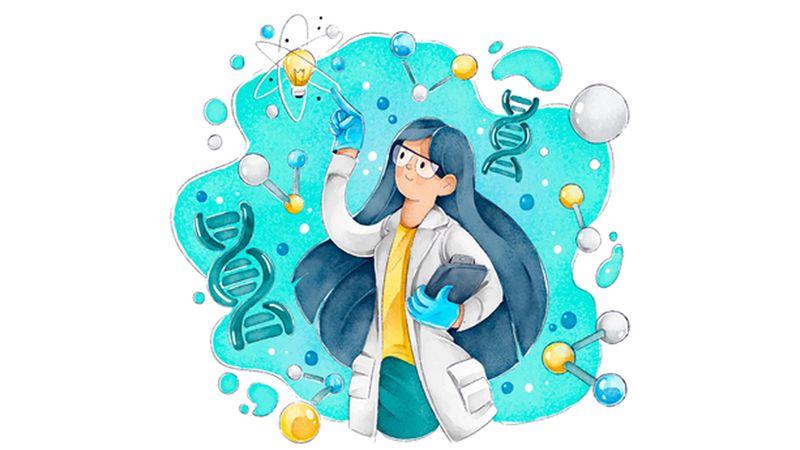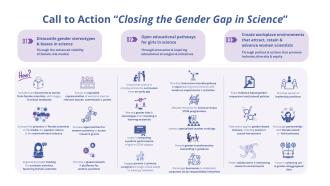
“Are you in research and have two kids? How are you managing both–your research career and the family?”
“There is a break in your career. Will you be able to restart your career all over again?”
Women in science often get asked these questions. I wonder why these are not the basic questions for men who also go through family commitments and responsibilities? Women are multitaskers and visible on multiple platforms in everyday life. Yet these are the questions they have to answer at every stage. Women in science are gladiators. In one sense, they are always in combat, tackling challenges on multiple fronts — caste, religion, gender, equality and funding.
Anna Mani, Annapurni Subramaniam, Raman Parimala, Rathnashree, Rohini Godbole, V Shanta, Soumya Swaminathan, Sujata Ramdorai — the list of successful Indian women in science goes on.
Unfortunately, women in science were not encouraged for decades. Although her dissertation involved ample research work, Anna Mani, a student of Prof C V Raman, was refused a PhD at the Indian Institute of Science (IISc). Unfazed, Mani specialised in meteorological instruments at Imperial College London. After returning to India, she joined the Indian Meteorology Department (IMD). Her contributions have led her to be called the Weather Woman of India.
“The good part is that women become role models very easily. Especially for their kids, gender bias is broken down quite early. This is why women in science are important,” says Dr Vinita Gowda, Associate Professor, IISER Bhopal.
Research and Fieldwork
In the journey of being a Scientist, obtaining a PhD is difficult and takes time. After embarking on their PhD, one has to face several obstacles to reach it to defend their PhD. There is an absolute shot drop in girl candidates post-PhD for many reasons. Women step back from choosing pure science as a career option, as they feel that late evening meetings, travelling for seminars and workshops, and fieldwork and surveys are challenging amidst family commitments.
Unlike PhD programs, postdoctoral fellowships make research fellows think and act independently. The researcher must select a topic, plan the research lab, fieldwork and budget, and process purchase orders for instruments and material. All these need independent decision making and the skill to execute the project to completion. Additionally, women, especially those from tier-2 cities, need to overcome several barriers. They have lesser exposure to big cities, need to travel to and from remote locations to work and may not be very conversant with English. But despite the barriers, research is fulfilling and enjoyable.
“Fieldwork! Not so different for a woman, who does household chores, toils in agricultural fields, and brings down wood from forests. It’s a doable thing,” says Dr Vinita.
Maternity Break
A big question for women is coping with the maternity break, mostly when charting their career in science. What is the comeback situation post-maternity leave? One has to be in touch with topics related to research constantly. Getting back to research and the mindset of balancing work and family is not easy.
Legally, there is a Maternity Benefit Act for female workers, allowing them to get a maternity break at any stage of research. Yet, not all private colleges and institutes in tier-2 cities don’t offer the facility. Rajiv Gandhi National Creche Scheme for the Children of Working Mothers provides daycare facilities for working women in the community. It took more than ten years from when the scheme was announced to bring it to the implementation level. Institutes like IISER Pune have established daycare facilities for their women employees and also offer the same for those women who visit institutes for workshops and conferences. Like IISER, how many institutions or colleges have provided this scheme?
“My son accompanies me in my fieldwork. It is fun to see him learning along. Yet it is difficult to do sampling with him being around,” says Dr Priti Gururaja, Inspire Fellow, Centre for Ecological Sciences, Indian Institute of Science, Bengaluru.
Even after crossing all the hurdles, pursuing a PhD/ postdoctoral fellowship might not be an option as the age limit for most PhD entrance exams like GATE, UGC-NET, or CSIR-NET makes it impossible to get into research after a career break. One has to constantly be updated about the topic of interest during the break period to take off smoothly when she gets back to work.
Sexual harassment, implicit and explicit, is another challenge women in academics face. There is an attempt to address the issue through a sexual harassment cell in major national/ international/ government institutions. Some of these institutions have established a ‘POSH (Prevention Of Sexual Harassment) at workplace’ committee that helps institutes adopt best practices for a safe and equal opportunity workplace. Having a POSH cell and awareness drives should be mandatory in all institutes, and administration should ensure these are not namesaked facilities. They should be practically operational.
Leadership and Recognition
To bring about a change at a societal level, girls should reach leadership positions. Most women at higher positions are either from privileged classes or second-generation scientists. Males still dominate most senior leadership positions. A cursory look at the directors of institutions of national importance in the country shows very few women scientists at the helm. Dr Vandana Prasad, Director of Birbal Sahni Institute of Paleoscience, Dr Priya ABraham, NIV, Pune, Dr Manju Sharma and Dr Renu Swarup, former secretaries of DBT, Dr Annapurni Subramaniam, Director of Indian Institute of Astrophysics, Dr Tessy Thomas, Director General, DRDO, and Dr Dhriti Banerjee, the first woman Director of Zoological Survey of India, are some exceptions.
Under the Ministry of Science and Technology, the Department of Science and Technology (DST) offers schemes such as WOS-A, WOS-B and WOS-C that encourage Masters, PhD students and women with a break in their careers to get back to research. The Department of Biotechnology (DBT) also offers many opportunities for women scientists. Slowly but surely, women are occupying many leadership positions. Now, their additional responsibility is to encourage women by organising inspiring talks, small grants/fellowships and many more workshops to help build their careers.
Even for prestigious research awards, women awardees are far less than the percentage of women in the respective fields. When women don’t find the proper representation and opportunities, how can they even think of winning any awards?
Workshops, seminars, fellowships and awards, academic positions as well as government policies need to be revisited with a focus on accommodating women of all categories. An example would be to provide age relaxation for attempting competitive exams and PhD interviews.
Even social media platforms make noise about how women could be brought into prominent roles. For instance, “Bias Watch India” (@biaswathindia), a Twitter-based initiative, documents gender-biased panels (often called ‘manels’ when there are no women representations) in Indian STEM (Science, Technology, Engineering and Mathematics) conferences and similar events. Women in STEM Research (WISR) India works for Indian women and gender minorities by studying the community and collaborations using social media. The Life of Science, a science media platform, focuses on highlighting the work of women and minorities across research institutes in India.
The good news is the funding agencies in India and their schemes for women in science are far better than in other countries. To begin with, maternity leave and creche availability are easy in India, at least in major institutions. Indian funding agencies should continue to bring the work of women research fellows to notice by organising women’s career programs at the individual, research groups and institutes level.
To conclude, we would definitely mention books, such as ‘Leelavati’s daughters’, ‘Women in Science, 50 fearless Pioneers who changed the world’ and ’31 Fantastic Adventures in Science’, that elaborate the work and life of women scientists across the world. These are illustrated books showcasing contributions of women to science that definitely encourage and motivate, help women understand the pros and cons in any research arena, and overcome the hurdle that discourages them from doing science.
We just have to light the lamp and lead the way.
An earlier version of this article was published in Deccan Herald.






